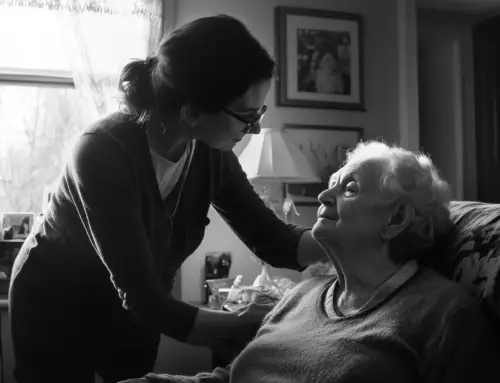Learn more about how you can help your loved ones with in-home care.
Interventions save lives. Nurse intervention is considered the backbone of home care.

The term “nursing intervention” describes any type of action a nurse performs to improve their patients’ comfort and overall health. Those who are considering the advancement in nursing should understand that interventions are a crucial practice they will be expected to master.
This article will learn what nursing interventions are, what they entail, examples of nurse interventions, and how you can master this important aspect in proper medical care.
What are nursing interventions?
According to the Journal of Nursing Education, nursing interventions are:
- Any task that a registered nurse does for a patient
- Anything a nurse does that may lead or is intended to lead directly to a patient outcome
Nurse interventions can involve direct or indirect approach methods-depending on the patient’s desired outcome and unique situation. An older adult can often benefit from, or even require, a nurse to intervene in certain areas of their overall health care. Seniors can develop a resistant attitude towards receiving care when they need it. This often happens when the care they require involves (what feels like) an invasion of their personal space. That said, no matter what area of expertise or specialty healthcare professionals work in, the nursing process is the same.
Nursing interventions fall into three main categories:
- Independent. Nurses perform independent interventions every day while they are working. A nurse can perform independent nursing interventions without assistance or input from others. Nursing outcomes only require one certified caregiver to carry out care plans. An example of independent intervention would be medication adherence, or a nurse educating a patient on the importance of taking their medication as prescribed.
- Dependent. Dependent nursing interventions require a direct order from a physician, and cannot be performed by a nurse alone (For example, when a physician orders a new prescription medication for a patient).
- Interdependent. These interventions involve multiple members of a healthcare team to perform tasks smoothly and properly. A care team will work together in caring for a patient during an intervention. An example of an interdependent nursing intervention could include a patient recovering from ankle surgery who is prescribed pain medication by a physician, administered by a nurse, and participates in routine physical therapy by a specialist.
Examples of general patient care areas include:
- Sleep control, or sleep pattern control
- Mobility support and therapy
- Diet monitoring
- Infection and dressings control
- Alcohol or drug abuse control
- Positioning physical therapy
- Bedbound therapy and bedside care
- Energy conservation methods (heart failure, etc.)
- Postpartum support and aftercare
What are examples of nursing interventions?
So, what’s the difference between Nursing Intervention & Nursing Assessment?
Many people find themselves confused regarding the differences between nursing interventions and nursing assessments. Although both are incredibly essential aspects of a nurse’s work, the nursing practice is different and distinct in many ways.
Nursing Assessments
A nursing assessment can be done by either a nurse or a physician. Caregivers know how to perform an overall nursing diagnosis of individuals, which provides insight into the patient’s symptoms and the ailments they’re experiencing. According to AMN (the American Mobile Nurses), there are four nursing diagnosis types:
- Abbreviated Assessments-these types of assessments are performed when lengthy evaluations are NOT required.
- Comprehensive Health Assessments-medical assessments performed when a thorough evaluation of a patient’s health is required.
- Assessments for Special Populations-these types of medical assessments are used for medically significant groups of people. Groups like these include the elderly and infants, for example.
- Problem-Focused Assessments-these assessments were designed to provide a focus on specific ailments or medical care issues.
During Nursing Assessments, registered nurses gather information about:
- Patient health history, including any chronic illness
- Patient problem or primary complaints
- Status of current health
- Overall condition of one’s external body, and surfaces such as the skin
- Review of any past or present, or potential future neurological conditions
- A review of internal systems such as cardiovascular, pulmonary, or musculoskeletal
- Patient nutrition status
- Mental health status
- Supportive care at home
Nursing interventions occur based on the results of nursing assessments. Although the ultimate goal of a patient assessment is to decide upon the right course of treatment, appropriate interventions are often worth a treatment. A nurse intervention may go beyond a general review of the patient’s medical state and/or status. The following actions may be performed during a nursing intervention:
- Stress control and crisis therapy
- Terminal care, such as hospice
- Bereavement support groups
- Free meals, such as Meals on Wheels
- Basic communication between nurses and physicians
- Coordinating nursing care, such as conducting routine checks and reviewing status reports
A thorough system is used to review and identify this type of work. Nursing interventions are a broad topic, describing nearly every interaction a nurse may have with their patients.
What is the Nursing Interventions Classification System?
As previously stated, everything a nurse does for and with a patient may be considered a part of a nurse’s overall intervention. Therefore, the Nursing Interventions Classification (NIC) system is designed to categorize every possible intervention a nurse may perform. In addition, the NIC intervention provides a platform for easy communication regarding interventions with other medical professionals, all while documenting the tests and evaluations they perform on a patient throughout an intervention.
Keeping this system up-to-date is constantly evolving through practice, evaluation, and regular updating to meet the proper standards and requirements. This system ensures thorough care and a therapeutic relationship is provided to every patient.
The 6th Edition of the Nursing Interventions Classification outlines several uses for this system, including:
Tracking and saving clinical documentation
- Tracking and saving clinical documentation
- A standardized communication system regarding patient care
- Research on intervention effectiveness
- Measure productivity and success
- Competency evaluations
- Thorough curriculum and design
- Types of Nursing Interventions
Types of Nursing Interventions
The Nursing Interventions Classification (NIC) system involves several levels of classification. Level one contains the following types of interventions:
- Community Nursing Interventions -Focus primarily on overall public health initiatives, such as planning a free 5k race in your town, or implementing a free diabetes education program.
- Family Nursing Interventions -Intervention that impacts an entire family, such as a program that offers support for new mothers learning how to breastfeed.
- Behavioral Nursing Interventions -Offer assistance, including actions, that help a patient change their own behavior. An example of a Behavioral nursing intervention would be offering support and coping methods for a patient who wishes to quit smoking.
- Health System Nursing Interventions -Actions taken by nurses as part of a healthcare team, focusing on things like patient safety. These may include procedures that reduce the risk of infection for patients during stays at a hospital.
- Physiological Nursing Interventions -Related to a patient’s physical health. An example of this form of intervention would be physiological procedures such as providing IV fluids to a dehydrated patient. Nursing interventions of this type come in two categories: Basic and Complex.
- Safety Nursing Interventions -Actions that are aimed to help maintain a patient’s overall safety and well-being. An example of Safety Nursing Interventions would be educating a patient regarding their ability to call for assistance if they cannot move around safely on their own.
It is important to mention that, although the number of interventions can seem daunting, most nurses do not need to be familiar with all of them. No nurse will use every type of intervention. Whatever your nursing care plan is, it will require some adaptations along the way, depending on the nursing action required for the intervention. A nurse will study and master the intervention types which apply to their area of expertise and medical practice.
Nursing Interventions Performed Every Shift
An example of nursing interventions that are performed on every shift of an on-duty nurse include the following:
- Actively Listening to Patients-This is a task you complete with every patient you come in contact with as a nurse. Although active listening is generally covered in mental and behavioral health, it is essential to do so with patients in every health stage to support their overall well-being.
- Preventing Falls-Particularly within the care of elderly patients, nurses understand that there is a risk of falling and potentially injuring oneself among their patients. By educating them on using their bed alarms and ensuring non-skid socks are being used when needed.
- Pain Control-As a nurse, you actively ensure your patients are comfortable and not in constant pain. Although not every patient will be prescribed pain medication, those with prescriptions must be monitored at all times.
- Cluster Care-This is a vital part of every nurse’s shift, ensuring that others on staff that day are made aware of each patient’s needs and that those needs are met.
- Promoting Position Changes-Nurses must promote position changes to avoid bedsores. This is especially true among elderly patients. By ensuring movement is made, nurses can help avoid painful sores and bruising.
- Ensure Adequate Oral Intake-It’s common for patients who are sick in the hospital to be dehydrated, often feeling too ill to orally drink fluids. That said, patients who can orally ingest fluids must do so regularly as part of the nursing process, to avoid extreme dehydration.
Conclusion
As a practicing nurse, you will see just how often your regular day-to-day duties involve nursing interventions in one way or another. Most nurses will be practiced in providing usual care to patients in acute pain, preventing falling among patients, preventing bedsores and ulcers from developing, and encouraging your patients to do as much as they can to protect themselves and stay healthy.




